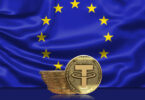Today, the cloud-based procurement and invoicing platform Tradeshift announced it carried out a transaction on the Ethereum blockchain with Monerium’s e-money for settlement. ConsenSys-backed Monerium was granted the license to issue e-money on blockchain by the Financial Supervisory Authority of Iceland.
One question is what’s the difference between a “stablecoin” and e-money. Monerium’s co-founder and CEO Sveinn Valfells explained to Ledger Insights: “The term “stablecoin” refers to a collection of non-uniform user agreements of various issuers of fiat-linked tokens. E-money, however, is a digital alternative to cash defined in EU law; only authorized issuers can use the term.”
He continued: “It is a technically neutral standard which dates back to 2000 and has previously been used on other media, such as cards. Because it is a well-defined and established licensing framework for digital cash which predates and is independent of blockchains, it would be inappropriate to refer to e-money as a stablecoin.”
In the Tradeshift transaction, Icelandic retailer Nordic Store purchased goods from IKEA Iceland. Ikea then issued an e-invoice using Tradeshift’s platform. On Ethereum the smart invoice is represented as a token – a right to the future payment.
The buyer authorized the invoice for payment both on the Tradeshift platform and also on Ethereum. Hence when the invoice became due, the payment using Monerium’s e-money was automatically triggered by the smart contract. Because the settlement used regulated e-money, a digital version of Krone, Monerium believes this transaction model could have “significant global impact and outreach.”
Stefán Árnason, CFO of IKEA Iceland, said “a programmable financial supply chain, where trading partners can connect information flows to money flows through smart contracts, will transform how suppliers and customers interact.”
There are several potential benefits to the combination of e-money and smart invoices. Payments are automated and predictable, and there’s a reduced risk of human error. Potentially cross border payments could be far cheaper than regular bank payments. Additionally, by using tokenization SME’s may gain access to trade finance more easily than is currently the case.
“We see smart invoices not just as useful for lowering administrative hurdles in business-to-business (B2B) cross-border transactions, but for building new financing models that makes it easier for enterprises to improve access to credit and improve cash flow. That is why we have built the world’s first smart invoice and now settled it with licensed digital cash together with Monerium. This is an important step forward,” said Gert Sylvest, co-founder of Tradeshift and GM of Tradeshift Frontiers.
He continued, “If you sell the tokens back to the buyer, you basically have dynamic discounting. If you sell them off to a financier, you have Supply Chain Finance. If you use them as collateral in order to provide finance to sub-suppliers, you have what some call ‘Deep Tier Finance’ and what we call ‘Ecosystem Finance.’ You then avoid double-dipping finance fraud, which is when the supplier sells the same invoice two or more times, because now you can only sell a token once.”
For some time Tradeshift Frontiers has been working on a blockchain platform Tradeshift Cash targeting just the sort of financing that Sylvest describes. Tradeshift clarified to Ledger Insights that Tradeshift Cash now refers to early payment solutions, independently of whether blockchain is used or not.
Tradeshift became a unicorn startup last year when it raised $250 million in a funding round led by Goldman Sachs among others.






